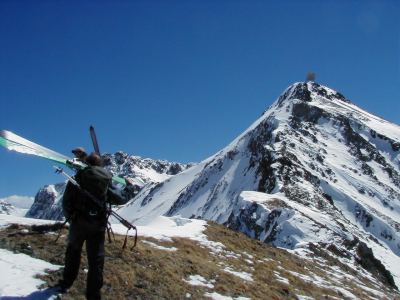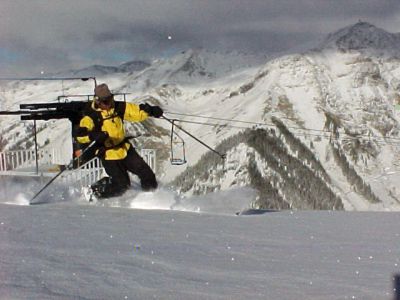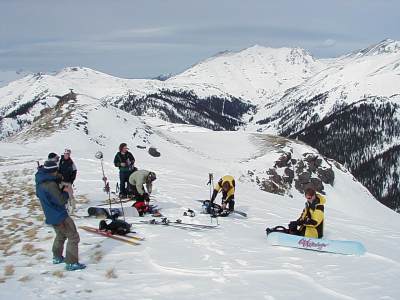Article by Allen Best
Skiing – January 2003 – Colorado Central Magazine
AS BEST I CAN FIGURE, the story at Silverton is about how much sex you can have before you cease being a virgin. Aaron Brill professes near virginity with his new Silverton Mountain Ski Area, and if I sound skeptical, perhaps even cynical, maybe it’s because I haven’t been among those reporters who have trouped to this newfound Shangri-La of 50° slopes, 13,000-foot peaks, and just one lift.
For more than a year now, Silverton Mountain has been portrayed as everything right in a sport that has gone bad. Skiing, goes the mantra, has sold out. It’s all about real estate and nothing about the thrill of gliding on snow. It’s all about numbers, and nothing about the pure joy of the mountains.
In a state where Vail is a four-letter word in more ways than one, Brill has vowed to be the UnVail, the UnAspen, the UnResort of your choice. He is seeking a permit to use 1,300 acres of public lands, a chunk of land as sprawling as Telluride, but promises to cap skiers at 400 a day. Instead of a $71 lift ticket, he vows $25. And although he owns 350 acres at the site, located six miles north of Silverton, he declares he won’t develop real estate, sell T-shirts, or adopt any of the other wallet-invading techniques that other modern ski area operators have used to grow their revenue streams.
Instead, he pledges to offer only the simplest of amenities, such as burgers and beers and perhaps cabins. “The bare minimum, what I would want to see if I went someplace else,” he told me when we chatted last spring.
In Colorado, where ski towns have bloated into lifestyle valleys during the last 20 years, such iconoclastic talk is appealing. This notion of smaller and simpler plays well in the minds of baby boomers waxing nostalgic about the supposed golden era of skiing — which just so happens to coincide with when they were young. And Brill’s emphasis on the steeps plays well with the Generation X’s very real testosterone bravery, now captured in the one-size-fits-all marketing phrase called “extreme.”

In short, this story about a rusting ski lift tucked away in an obscure valley of the San Juan Mountains has all the inner tension of arguments being quietly waged in mountain towns throughout the Rocky Mountains. We all want to think we live in places untainted by the hustle of money. We all want our lives rigorous and muscular, and attached closely to the land.
And, in many minds, the modern ski industry is none of the above, but instead a sport gone effete, limp and ridiculous, a self-parody. It’s one thing to have a ski lift carry you up the hill, but quite another to have an outdoor escalator to convey you from heated pavers to the detachable quad, as is found at Beaver Creek.
But are the two really all that different?
FOR STUDENTS of symbolism, the story of Silverton and Brill can’t be beat. After all, Silverton is where Pete Seibert spent the summer of 1954, clerking at the Grand Imperial Hotel by night and wandering the San Juans by day.
Ever since he was a child in Massachusetts, Seibert had dreamed about someday having his own ski resort. After horrors in World War II, pleasures in Aspen, and studies of resort management in the Alps, Seibert set out to realize his dream. Near Silverton, however, he saw only potential for a small ski area. For the sort of ski resort he had in mind, Seibert needed gentler slopes and closer proximity to a major population center.
Three years later Seibert found the place — Vail. To make the ski area happen, his company, Vail Associates, sold lots at the base. The village that evolved seems casually haphazard, but Seibert carefully monitored everything built in that first phase. He wanted the dream executed just as he had imagined it after looking at photos of Swiss villages as a child.
Like Seibert, Brill’s passion for ski-area building can be traced to the other side of the world, in his case New Zealand, which he visited in 1992. There, Brill discovered small ski areas, staffed primarily by volunteers, where nothing more fancy than a rope tow accessed thousands of acres of extraordinary skiing. Fittingly, while in New Zealand, Brill bought the Sorrel boots he now uses for his similarly aged snowboard.
RETURNING TO THE STATES, Brill bounced around ski towns in Montana and Colorado, and nurtured the idea of having his own ski area. Lake City, he discovered, had a dormant municipal ski area. Thumbing through a DeLorme map book, he flipped the page to Silverton. There he noticed chunks of white space indicating private land amid the greenery of federal land around the old Sunnyside Mine and the ghost town of Gladstone. Topo lines were even snugger, indicating steepness.
No singular model in the United States exists for what Brill began planning at Silverton. Sure, there are low-cost ski areas. Silverton already has one, called Kendall Mountain, a rope tow on the outer perimeter of the town. Near Leadville, Ski Cooper remains cheap and simple and, except for just a few weekends each year, uncrowded. Arguably Monarch and Wolf Creek are both cheap and small — these qualities being increments, not absolutes. But none have the unrelenting steepness of Silverton Mountain.

In fact, the World Speed Skiing Championships had been held there on Storm Mountain in 1981, 1983, and again in 1991. The mountain had even informally been named Velocity Peak.
When Brill arrived to inspect the topo lines in the flesh in 1999, what he found looked even better than what he had seen on the map. Chasing down the 20 or so owners of former mining claims on his chosen mountainside, Brill purchased 350 acres. Target price, he says, was $1,000 an acre.
On this land he has installed a 28-year-old lift — purchased from California’s Mammoth Mountain — which rises 2,000 feet, terminating well above treeline. Brill did everything by hand and on foot until the helicopters dropped the 15 lift towers into the concrete pads in autumn 2001.
Silverton residents have welcomed Brill with few exceptions. Since 1991, when the Sunnyside Mine closed, putting 800 people out of work, San Juan County has consistently had the highest unemployment rate in Colorado. In summer, when 2,000 to 3,000 people live in Silverton, the economy is strong and largely connected to the twice-daily runs of the narrow-gauge railroad from Durango. In winter, the trains stop running, and the town’s population slumps to 500 or less in winter.
MONTHLY SALES TAXES sag more severely yet, from summer highs of $95,000 to winter lows of $6,000. There is even concern that the school must be closed — only 40 students remain. Many residents see this as Silverton’s new gold mine, if a small-producing affair. Last winter, his ski area employed only eight, including Brill and his partner, Jenny Ader.
However, to get more than a handful of customers, Brill needs access to federal lands. From where his lift tops out on private land at an elevation of 12,247 feet, skiers and snowboarders can hike to gain access to 1,300 acres of Bureau of Land Management property. Elevations top out at 13,300 feet.
To Brill’s dismay, the BLM has required an environmental impact statement of the ski area proposal involving public lands. The EIS costs around $130,000 and takes about 18 months to complete. One reason for the more thorough assessment, says Richard Speegle, project manager for the BLM, is that Silverton Mountain lies in a possible corridor that connects habitat of the Canada lynx, a species protected under the Endangered Species Act.
AVALANCHES, THOUGH, are the overriding issue. “There’s really nothing like it in the lower 48 states, where you have lift access to that sort of avalanche terrain,” says Speegle. Also, unlike New Zealand, the U.S. government implicitly assumes responsibility for public safety when it grants a permit for commercial skiing on federal lands, and that onus is, in turn, put on the shoulders of the ski area operator.
Merely getting to the ski area requires driving on a road for six miles that is located below 45 named avalanche paths. But 90% of avalanches that capture people are triggered by their victims. That danger picks up sharply on slopes of 30° or more, and Silverton’s slopes start at about 35° , and many of the ski trails descend into 50° funnels that are bordered by thick trees.
With enough skiers, snow can be compacted, diminishing risk. But at Silverton Mountain, there is too much terrain — nearly as much as Telluride — for so few skiers to compact, and 50° slopes are difficult to manage no matter how many skiers there are.
Snowpack forecasting will become more important, says Craig Sterbenz, Telluride’s snow safety director and a consultant to Silverton Mountain, but he doesn’t see avalanches alone breaking the idea. “Almost any avalanche problem can be dealt with,” says Sterbenz. “It’s just how much money you’re willing to spend.”
UNTIL HE GETS the permit from the federal government, which many seem to think he will, Brill has authority to conduct guided tours of up to 40 skiers a day on public lands. To qualify, clients must first pass an avalanche awareness test and then carry beacons and shovels. Cost of these guided tours is $99 a day.

This, says Ed Ryberg, sounds an awful lot like helicopter or Sno-cat powder skiing. Ryberg, a Forest Service winter sports administrator who has skied or snowboarded most of the resorts of the West, has unflinching praise for Brill’s determination and for the terrain. “It’s excellent skiing, there’s no doubt about it,” he says.
Ultimately, however, he foresees Brill retreating from his dream of low-priced, high-quality skiing for a few hundred people. To make the numbers work, he predicts, Silverton Mountain will ultimately provide a small amount of so-so terrain for yo-yo skiing, then provide the guided tours — at a premium cost — to access the steeper, more avalanche-prone terrain. Even $10,000 a day in revenue, Brill’s maximum under his scenario, is unlikely to cover the cost of such an operation.
As is, Ryberg says, Colorado ski areas make a big play for this narrow market of steep and deep: Telluride with Prospect Basin, Copper Mountain with Tucker Mountain, even Breckenridge and Winter Park and now Aspen Highlands.
But the best parallel may be at Berthoud Pass. A tiny ski area, among Colorado’s oldest, it’s only an hour’s drive from metropolitan Denver’s two million residents, the largest concentration of skiers in North America. Yet, as a conventional ski area, Berthoud Pass got only 25,000 skier days, and income fell short of expenses.
LAST YEAR, after converting to a Sno-cat skiing operation, Berthoud Pass’s skier days seemed to do better. Similarly, Ryberg reasons that Silverton Mountain’s ultimate niche will be to mine the 40- to 50-year-olds who can afford $100 for a day of high-quality guided skiing.
The real question at Silverton, suggests Ryberg, is how deep Brill’s resources are. “Can he stay in there until these processes, such as the EIS study, have run their course, and then the real hard part begins?”
In Silverton, meanwhile, Nicole Barr is leaning against the wind of local sentiment. Nearly all of the town’s year-round residents support the ski area, but Barr sees Brill’s great adventure as a mistake for two reasons.
First, she sees too much danger from avalanches. As a backcountry skier who skies 150 days a year, Barr says she avoids the area around the ghost town of Gladstone, where Brill’s ski area is located, until March at the earliest. “I just think the place he picked was wrong,” she says.
FOR THAT MATTER, anyplace around Silverton would be wrong in Barr’s view. She sees Brill as just another developer of a seasonal economy. From Aaron Brill to Pete Seibert to Vail Resort is just a matter of increments.

“I have lived here for 11 years, and I don’t work in winter, and we even have a kid and have figured out a way to buy a house. We save our money during summer to get through the winters, and other people can too,” she told me when I called her.
Barr says she chose to live in Silverton specifically because it had no ski area, and because it was unlike most Colorado mountain towns. Even one lift is starting down the road to some place Barr doesn’t want to stay. “That’s how Telluride started out, with just one lift, and how Aspen started out, with just one lift,” she says.
Whether Brill’s ski area ends up with 20-year-old Gen Y snowboarders or 50-year-old baby boomers, Barr sees little real gain for Silverton. Either way, she sees a downhill ski area as a false savior for Silverton’s winter economy. Better, she says, to entice year-round enterprise of some sort.
So there you have it. Aaron Brill is offering something different in skiing, but critics are afraid that Brill’s ski area can’t stay different and make it financially.
And Silverton — or at least one resident in Silverton — doesn’t want to become like Crested Butte, and Crested Butte doesn’t want to become like Aspen, and Aspen doesn’t want to become like Vail. And for it’s part, I suppose that Vail doesn’t want to end up like Silverton, either.
Allen Best has edited newspapers in Vail and Winter Park, and now pubishes an Internet newsletter, Mountain Town News, which covers resort towns from British Columbia to New Mexico.

